The Economics and Statistics Division maintains archives of previous publications for accountability purposes, but makes no updates to keep these documents current with the latest data revisions from Statistics Canada. As a result, information in older documents may not be accurate. Please exercise caution when referring to older documents. For the latest information and historical data, please contact the individual listed to the right.
<--- Return to Archive
For additional information relating to this article, please contact:
June 05, 2020LABOUR MARKET TRENDS - MAY 2020 Nova Scotia’s labour force survey results reflect the period from May 10 to 16, when there was different levels of easing of COVID-19 restrictions across jurisdictions.
Nova Scotia's seasonally adjusted employment level was up 8,600 (+2.2%) in May following on the 50,600 employment decline in April and a 24,800 decline in March. Nova Scotia’s employment is lower by 66,800 (-14.2%) since February 2020 as the COIVD-19 pandemic and public health measures to contain it have impacted the labour market.
Nova Scotia’s labour force increased by 17,900 (+4.0%) to 467,500 for May. The labour force in May 2020 is smaller by 43,400 (-8.5%) than February 2020. The number of unemployed persons was up 9,400 in May and is 23,600 higher than February. The unemployment rate increased 1.6 percentage points to 13.6 per cent in April. This is Nova Scotia’s highest unemployment rate since May 1994.
The population not in labour force fell 17,500 compared to last month. Compared to February 2020, are an additional 45,000 persons not in the labour force and 23,600 unemployed.
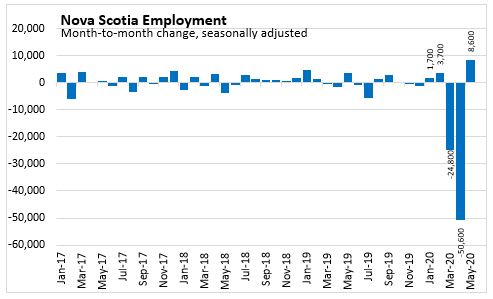
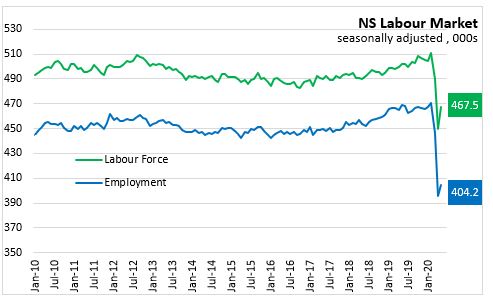
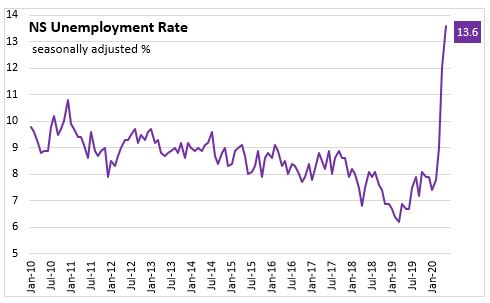
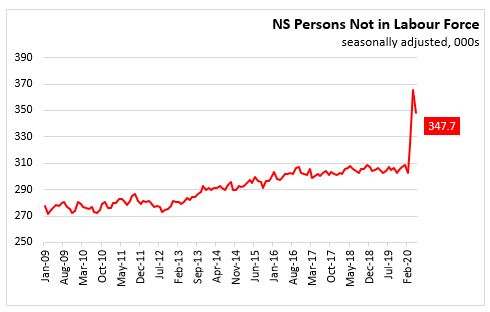
In May, full-time employment increased by 400 (0.1%) while part-time employment increased 8,100 (+13.1%). Employment since February 2020 is lower by 46,100 (-12.1%) in full-time jobs and -20,800 (-22.9%) in part-time employment.
With the population steady (+0.0%) in May 2020, the rise in labour force lifted the participation rate was 2.1 percentage points to 57.3 per cent. However, the participation rate remains 5.5 percentage points below the level observed in February 2020. The employment rate was up 1.0 percentage points to 49.6 per cent in May 2020 but remains -8.3 percentage points below May 2020.

In addition to those who have lost employment since February 2020, there are additional also identified that there are a further 56,800 who are still counted as employed, but had zero hours (and not for routine reasons like vacation, maternity/parental leave, labour dispute) or had their hours cut by 50 per cent or more. Combined with those who have lost their employment, this amounts to about 26.2 per cent of Nova Scotia’s February 2020 employment level. The largest total employment impact in May 2020 has been in Ontario at 28.6 per cent of February employment level, the smallest change has been in Manitoba (18.4%).
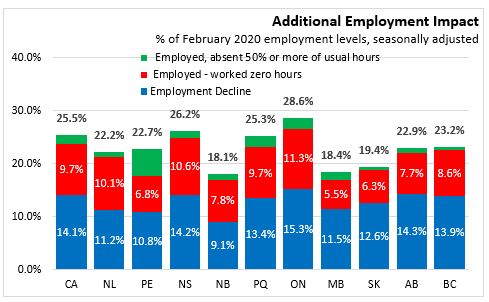
Statistics Canada reported in supplemental information that Nova Scotia had an increase of 35,100 (Feb20 to May20) of those who were not in the labour force but wanted to work. The recent labour underutilization rate is the proportion of the labour force plus those wanting work but not in labour force that are either not employed or absent from work. The rate has risen in every province since February. Nova Scotia in February 2020 has recent labour underutilization rate of 14.5 which has risen to 37.1 per cent in April 2020 and was unchanged in May. The largest increase in the rate was in Ontario where it has risen form 11.4 per cent to 37.4 per cent. The lowest recent labour underutilization rate is in Manitoba at 27.6 per cent.
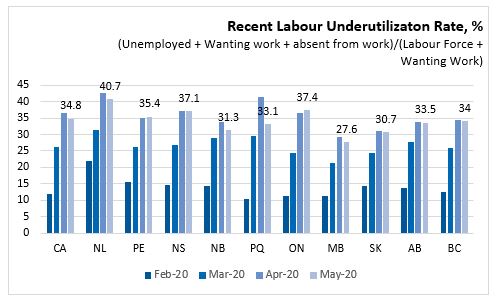
Age Cohorts
The monthly increase in participation rate was observed across all age groups. In May, the participation rate of younger Nova Scotians (15-24), increased 2.4 percentage points to 56.3 per cent – remains 16.7 percentage points below the level observed in February. For core aged Nova Scotians (25-54) the participation rate was up 3.8 to 83.4 per cent (down 4.5 percentage points since February), and for older workers the participation rate increased 0.5 percentage points to 30.8 per cent (down 2.7 percentage points since February).
Employment rates were up for youth (+3.2 percentage points) and core-aged (+1.6 percentage points) but were down 0.1 percentage points for older workers. Compared with February, employment rates for youth are down 20.1 percentage points while employment rates are down 8.8 per cent for core aged workers and 4.1 percentage points for older workers.
The unemployment rate was down 2.6 percentage points to 23.9 per cent for ages 15-24, increased 2.2 percentage points to 12.1 per cent for ages 25 to 54, and rose 1.9 percentage points to 11.7 per cent for those over 55.
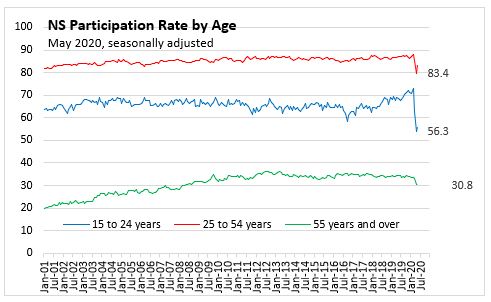

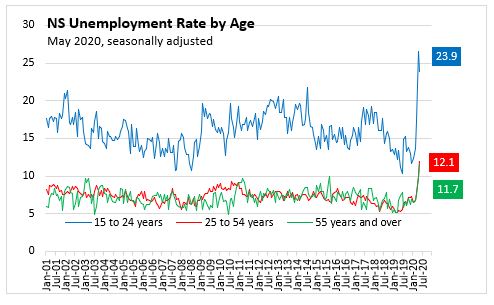
Comparing May 2020 to Feb 2020, the decline in employment mostly shows up in persons not the labour force rather than unemployment for youth and persons over 55. For persons aged 25 to 54, there has been similar increases in persons remaining in labour force as leaving the labour force.
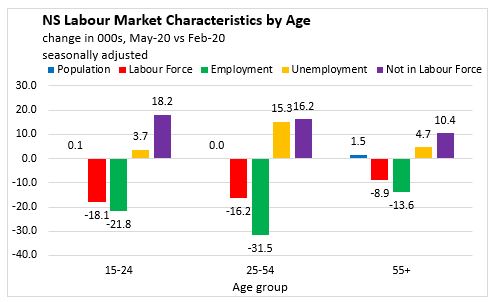
Males and Females
For May 2020, the monthly participation rate increased by 1.3 percentage points among Males to 60.3 per cent and by 3.0 percentage points among Females to 54.6 per cent.
The employment rate was up 1.3 percentage points for Males in May and by 0.8 percentage points for Females.
The monthly unemployment rate was down by 0.3 percentage points among Males to 11.9 per cent and up by 3.5 percentage points to 15.3 per cent for Females.
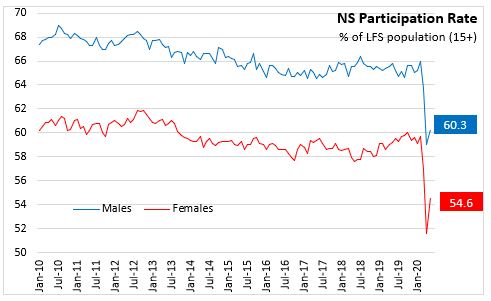

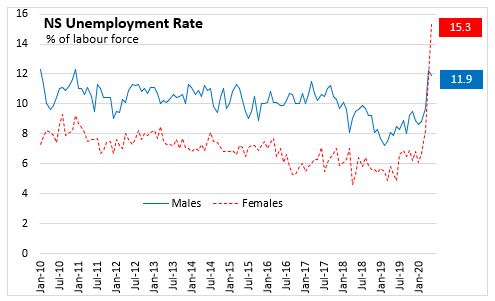
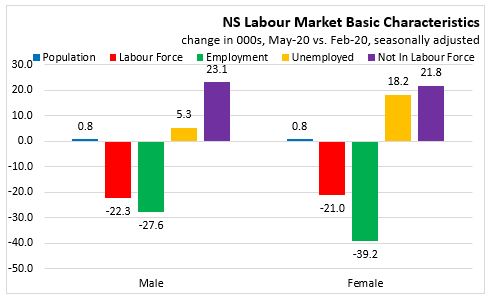
Compared with February 2020, male labour force is down 22,300 (-8.6 per cent) while female labour force is down 21,000 (-8.4 per cent). Male employment is down 27,600 (-11.6 per cent) while female employment is down 39,200 (-16.8 per cent). The number of unemployed is up 5,300 for males and 18,200 for females. The male population not in the labour force increased by 23,100 while the number of females not in the labour force grew by 21,800.
Sectors and Industries
Monthly employment increases in May were mostly in the private sector (+7,000) with self-employment (100) and public sector employment (+1,500) seeing smaller changes. Since February 2020, employment is down 66,800 with most of the decreases in private sector employees (-68,600). Self-employment has decreased -1,500 and public sector employees has risen 3,100. (Totals do not add due to rounding).
For May 2020, monthly employment increases were seen in construction (+2,600), wholesale/retail trade (+5,100), accommodation and food services (+1,800), and public administration (+2,000). Further job declines compared to April 2020 were seen in transportation and warehousing (-1,200) and health care and social assistance (-1,700). Other sectors had smaller changes in May.
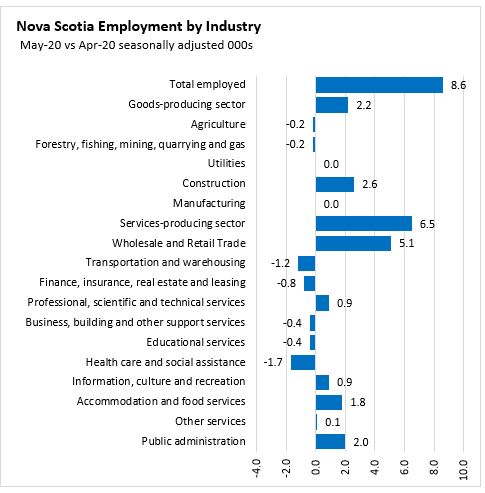
Employment since February 2020 has decreased 9,000 in goods-producing industries with lower employment levels concentrated in construction (-2,600) and manufacturing (-5,400). Service-producing employment is lower by 57,800 since February 2020 with the largest declines in wholesale and retail trade (-16,400) and accommodation and food service (-18,400). Employment declines also have been observed in health care and social assistance (-7,000 including child care services), information, culture and recreation (-6,200), other services (-3,700 including personal services such as hair care),transportation and warehousing (-3,100) business, building and other support services (-2,800 including call centres), and educational services (-2,700).

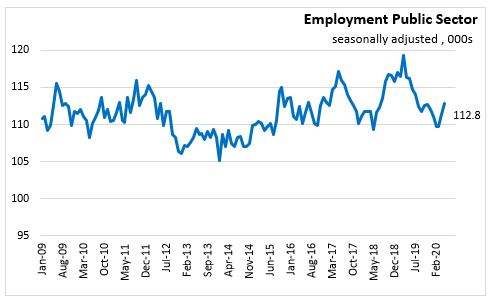


Regions – May 2020 vs. May 2019 (unadjusted 3 month moving average)
Comparing May 2020 with May 2019, Cape Breton employment is down (-6,000) while the labour force decreased by 4,200. The number of unemployed increased 1,800 and the unemployment rate rose 4.5 percentage points to 18.3 per cent.
For the North Shore region, the labour force decreased by 6,000 while employment decreased by 8,200. With labour force growing declining more than employment the number of unemployed rose by 2,100. This caused a 3.8 percentage point increase in the unemployment rate from 7.8 per cent to 11.6 per cent. There are 6,400 more persons not in the labour force compared to last year.
The Annapolis Valley reported a decrease of 7,800 in labour force and employment falling 10,300. Unemployment was up 2,600 and the net result was an increase in the unemployment rate by 5.7 percentage points to 11.8 per cent. There are 8,200 more persons not in the labour force in Annapolis Valley compared to last year.
The Southern region had a decrease of 4,800 in employment along with a decrease of 1,900 in the labour force. The unemployment rate increased 5.8 percentage points to 12.9 per cent for May 2020.
Halifax experienced a decrease of 22,400 in the labour force along with a decrease of 10,500 in employment. With unemployment rising by 11,800, there was an increase of 5.1 percentage points in the unemployment rate from 5.5 per cent to 10.6 per cent in Halifax. The number of persons not in the labour force increased 19,700 in Halifax compared to last year.
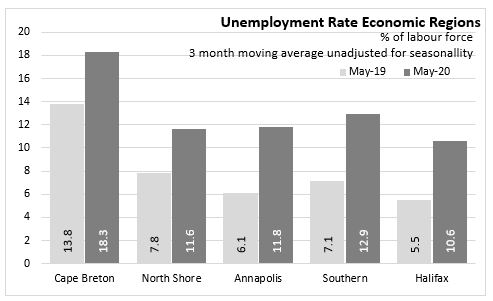

Provincial Comparisons
All provinces, except Ontario, report increases in employment in May. The largest employment increases was in Quebec (+6.5%) which accounted for nearly 80 per cent of the monthly increases. The pace of increase was faster in Atlantic region than Nova Scotia.
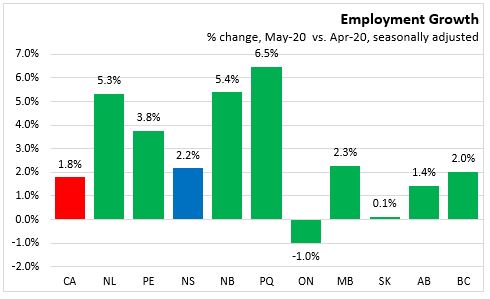
Compared to February 2020, labour force and employment are down in all provinces and the United States. The largest employment decline since February is in Ontario (-15.3%) and the smallest decline has been in New Brunswick (-9.1%). The largest decline in the labour force since February 2020 has been in Nova Scotia (-8.5%).

Unemployment rates climbed again in May 2020 for most jurisdictions. The highest unemployment rate for May 2020 is in Newfoundland and Labrador at 16.3 per cent and the lowest is in Manitoba at 11.2 per cent. Canada’s unemployment rate was 13.7 per cent in May 2020.

National Comparisons: Cities (Monthly, 3 month moving average)
The unemployment rate for the Halifax Census Metropolitan Area (CMA) in May 2020 was 10.5 per cent (3 month moving average). Abbotsford-Mission at 7.5 per cent had the lowest unemployment rate among CMAs while the highest was in Windsor, Ontario (16.7 per cent).
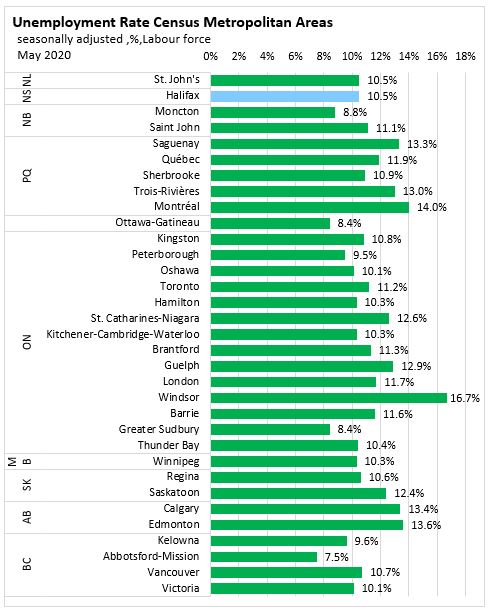
The seasonally adjusted employment rate for the Halifax was 56.8 per cent, down 2.6 percentage points compared to last month. Peterborough, Ontario (44.8 per cent) had the lowest employment rate, while Barrie, Ontario (63.5 per cent) had the highest.
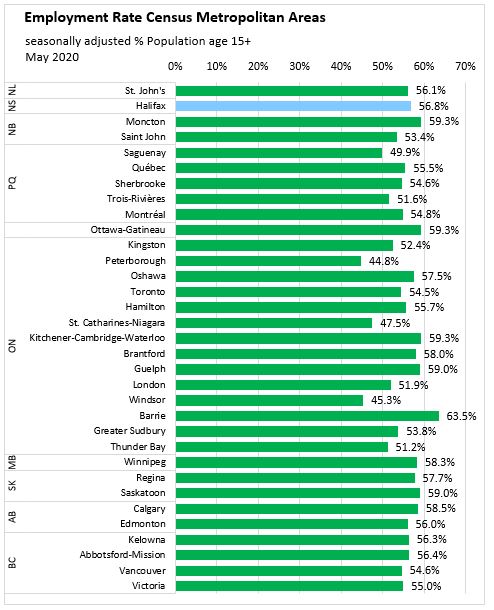
Halifax’s employment (3 month moving average) for April 2020 was down 4.3 percent compared to the March 2020 result. All CMAs reported lower employment in May. The largest declines in CMA employment was in Windsor (-8.4%) and the smallest decrease was in Brantford, ON and Moncton, NB (-1.1%).

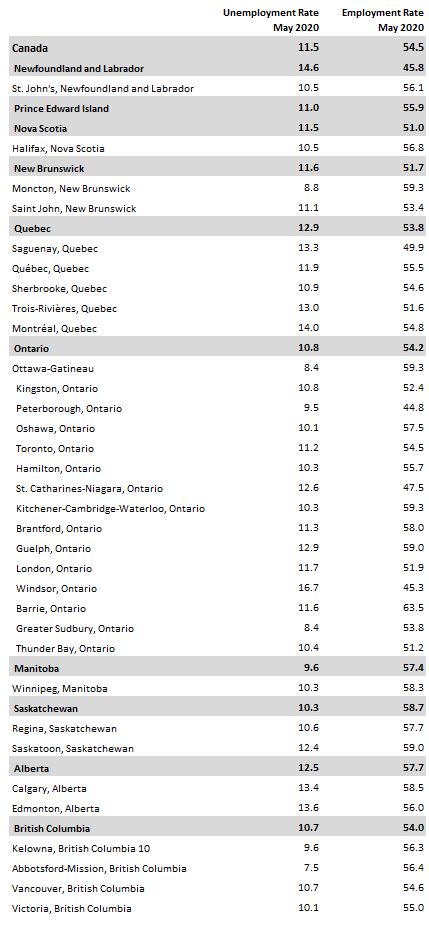
Note: Seasonally adjusted, 3 month average.
Sources:
Statistics Canada. Table 14-10-0287-01 Labour force characteristics, monthly, seasonally adjusted and trend-cycle, last 5 months
Statistics Canada. Table 14-10-0294-01 Labour force characteristics by census metropolitan area, three-month moving average, seasonally adjusted and unadjusted, last 5 months
Statistics Canada. Table 14-10-0293-01 Labour force characteristics by economic region, three-month moving average, unadjusted for seasonality, last 5 months
Statistics Canada. Table 14-10-0355-01 Employment by industry, monthly, seasonally adjusted and unadjusted, and trend-cycle, last 5 months (x 1,000)
Statistics Canada. Table 14-10-0288-01 Employment by class of worker, monthly, seasonally adjusted and unadjusted, last 5 months (x 1,000)
<--- Return to Archive